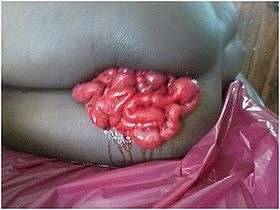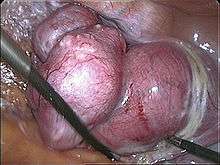Vaginal evisceration
Vaginal evisceration is an evisceration of the small intestine that occurs through the vagina, typically subsequent to vaginal hysterectomy, and following sexual intercourse after the surgery. It is a surgical emergency.[1]
| Vaginal evisceration | |
|---|---|
 Vaginal bowel evisceration with bright red blood oozing. | |
| Specialty | emergency medicine |
Presentation
Vaginal evisceration is typically obvious upon presentation, as intestine (typically ileum) can be seen protruding from the introitus. Other symptoms include a sense of pressure in the pelvis and vaginal bleeding.[1]
Causes
Vaginal evisceration is a serious complication of dehiscence (where a surgical wound reopens after the procedure), which can be due to trauma.[1] 63% of reported cases of vaginal evisceration follow a vaginal hysterectomy (where the uterus removal surgery is performed entirely through the vaginal canal).[2] Most instances of vaginal evisceration following a laparoscopic hysterectomy result from sexual intercourse among women approaching menopause, and from the combination of heightened pressure within the abdomen and weakened vaginal muscles among those who have experienced menopause.[3][4] Other risk factors include regular Valsalva maneuver, advanced age, obesity, smoking, immunosuppressive therapy, vaginoplasty, anemia, poor surgical technique, malnutrition, and postoperative/perioperative infection.[5][6] One case has been reported as of 2015 where placement of a pessary caused an evisceration.[5][7]
Dehiscence is more common in laparoscopic hysterectomy than in open hysterectomy.[8]
Prevention

When performing a vaginal hysterectomy, surgeons should aim to avoid damaging surrounding tissue or drying the vaginal cuff. Surgeons should take extra care to align the tissues, and include sufficient undamaged tissue. Instead of single-layer figure-of-eight sutures, two-layer sutures can aid in preventing vaginal evisceration.[3]
Treatment
Emergently, vaginal eviscerations are treated by keeping the exposed intestines moist and wrapped, while waiting for definitive surgical treatment.[1] Vaginal evisceration is usually treated by removing damaged tissue along the edges of the vaginal cuff, re-suturing the opening, and giving the patient broad-spectrum antibiotic prophylaxis.[3]
Surgery can be conducted via a laparotomy, though research from the 2010s shows that a transvaginal or laparoscopic approach can also be used safely and successfully if an infection has not developed. If left untreated, it can cause peritonitis or injury to the exposed bowel, including strangulation or mesenteric tears. Cellulitis, abscesses, hematomas, and other complications can appear at the same time as an evisceration. Abscesses and hematomas can be resolved after surgery with a surgical drain.[1]
Post-surgical treatment includes continuation of antibiotics and, in some postmenopausal people, vaginal estrogen to speed recovery. After surgery, people with vaginal evisceration are advised to avoid intercourse until the surgical site is fully healed.[1]
Epidemiology
Though it is a rare complication, as the popularity of laparoscopic hysterectomy has risen, the rate of vaginal evisceration has also risen. Vaginal cuff dehiscence occurs in 0.24–0.39% of cases; of these, vaginal evisceration occurs in 35%–67%.[1] When all surgical procedures are considered, the rate of vaginal evisceration is 0.032–1.2%.[2]
History
The first case of vaginal evisceration that was described in the medical literature occurred in 1864.[6][9]
References
- Matthews CA, Kenton K (2014). "Treatment of vaginal cuff evisceration". Obstet Gynecol. 124 (4): 705–8. doi:10.1097/AOG.0000000000000463. PMID 25198277.
- Cronin, Beth (27 August 2011). "Vaginal cuff dehiscence: Risk factors and management". Am J Obstet Gynecol. 206 (4): 284–8. doi:10.1016/j.ajog.2011.08.026. PMC 3319233. PMID 21974989.
- Hoffman, B.L.; et al. (2012). Hoffman, B.L.; et al. (eds.). Chapter 42. Minimally Invasive Surgery. Williams Gynecology (2 ed.). New York, NY: McGraw-Hill.
- Ramirez, Pedro T.; Klemer, David P. (Jul 2002). "Vaginal evisceration after hysterectomy: a literature review". Obstetrical & Gynecological Survey. 57 (7): 462–467. doi:10.1097/00006254-200207000-00023. ISSN 0029-7828. PMID 12172223.
- "Hysterectomy". DynaMed. EBSCO. 13 March 2015. Retrieved 4 May 2015. (Subscription may be required or content may be available in libraries.)
- Peltecu, GC; Vasilescu, C (October 2006). "Vaginal evisceration". International Journal of Gynecology & Obstetrics. 95 (1): 60–61. doi:10.1016/j.ijgo.2006.05.012. PMID 16828098.
- Rubin, Rachel; Jones, Keisha A.; Harmanli, Ozgur H. (Aug 2010). "Vaginal evisceration during pessary fitting and treatment with immediate colpocleisis". Obstetrics and Gynecology. 116 Suppl 2: 496–498. doi:10.1097/AOG.0b013e3181da371d. ISSN 1873-233X. PMID 20664431.
- Rivlin, Michel E.; Meeks, G. Rodney; May, Warren L. (Mar–Apr 2010). "Incidence of vaginal cuff dehiscence after open or laparoscopic hysterectomy: a case report". The Journal of Reproductive Medicine. 55 (3–4): 171–174. ISSN 0024-7758. PMID 20506682.
- M. Hyernaux (1864). "Rupture traumatique du vagin; issue des intestines à l'extérieur; application du grand forceps au détroit supérieur; guerison". Bull Mem Acad Med Belg, 2.